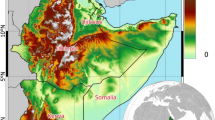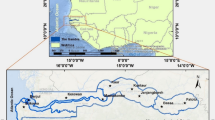Abstract
Droughts have adverse socioeconomic, agricultural, and environmental impacts that can be reduced by assessing and forecasting drought behavior. The paper presents detailed analyses of both meteorological and vegetative droughts over the period from 1970 to 2005. Standardized Precipitation Index (SPI) and Normalized Difference Vegetation Index (NDVI) have been used to quantify drought according to severity, magnitude and spatial distribution at the Hashemite Kingdom of Jordan. Results suggest that the country faced during the past 35 years frequent non-uniform drought periods in an irregular repetitive manner. Drought severity, magnitudes and life span increased with time from normal to extreme levels especially at last decade reaching magnitudes of more than 4. Generated NDVI maps spatial analyses estimate crop-area percentage damage due to severe and extremely severe drought events occurred during October, December, and February of 2000 to be about 10%, 45%, and 30%, respectively. In response to drought spatial extent, the paper suggest the presence of two drought types, local drought acting on one or more geographical climatic parts and national drought, of less common but more severe, that extend over the whole country. Droughts in Jordan act intensively during January, February and March and tend to shift position with time by alternative migrations from southern desert parts to northern desert parts and from the eastern desert parts to highlands and Jordan Rift Valley (JRV) at the west. The paper also investigates the potential use of Global Climate Model’s (GCM) to forecast future drought events from 2010 till 2040. Tukey HSD test indicates that ECHAM5OM GCM is capable to predicted rainfall variation at the country and suggests future droughts to become more intensive at the northern and southern desserts with 15% rainfall reduction factor, followed by 10% reduction at the JRV, and 5% at the highlands.
Similar content being viewed by others
References
Agnew C (1990) Spatial aspects of drought in the Sahel. J Arid Environ 18:279–293
Agnew C, Warren A (1996) A framework for tackling drought and land degradation. J Arid Environ 33:309–320
Al Salihi (2003) Drought identification and characterization in Jordan. J Arid Environ 53:585–606
Barrow E, Maxwell B, Gachon P (2004) Climate variability and change in Canada: past, present and future, ACSD Science Assessment Series No. 2. Meteorological Service of Canada, Environment Canada, Toronto, p 114
Bhuiyan C, Singh RP, Kogan FN (2006) Monitoring drought dynamics in the Aravalli region (India) using different indices based on ground and remote sensing data. International Journal of Applied Earth Observation and Geoinformation 8:289–302
Chiew FHS, Piechota TC, Dracup JA, McMahon TA (1998) El Nino/Southern Oscillation and Australian rainfall, stream flow and drought: links and potential for forecasting. J Hydrol 204:38–149
DOS (2003) Department of Statistics internal files, Amman—Jordan
DOS (2009) Department of Statistics internal files, Amman—Jordan
Environmental Systems Research Institute (ESRI) (2006) ArcView GIS version 9.2. A computer software to visualize, explores, query and analyze data spatially, USA
Frere M, Popov GF (1979) Agro meteorological crop monitoring and forecasting. Plant production and protection paper 17. FAO, Rome
Fujihara Y, Kenji T, Tsugihiro W, Takanori N, Toshiharu K (2008) Assessing the impacts of climate change on the water resources of the Seyhan River Basin in Turkey: use of dynamically downscaled data for hydrologic simulations. J Hydrol 353:33–48
Gibbs WJ, Maher JV (1967) Rainfall deciles as drought indicators. Bureau of Meteorology Bulletin No. 48. Commonwealth of Australia, Melbourne
Hammouri N, El-Naqa A (2007) Hydrological modeling of ungauged wadis in arid environments using GIS: a case study of Wadi Madoneh in Jordan. Rev Mex Cienc Geol 24(2):185–196
Hay LE, Clark MP (2003) Use of statistically and dynamically downscaled atmospheric model output for hydrologic simulations in three mountainous basins in the western United States. J Hydrol 282:56–75
Hay LE, Clark MP, Wilby RL, Gutowski WJ, Leavesley GH, Pan Z, Arritt RW, Takle ES (2002) Use of regional climate model output for hydrologic simulations. J Hydrometeorol 3(5):571–590
Hayter AJ (1984) A proof of the conjecture that the Tukey–Kramer multiple comparisons procedure is conservative. Ann Math Stat 12:61–75
IPCC (2001) Climate change: the scientific basis. In: Houghton JT, Ding Y, Griggs DJ, Noguer M, van der Linden PJ, Dai X, Maskell K, Johnson CA (eds) Contribution of working group I to the third assessment report of the intergovernmental panel on climate change. Cambridge University Press, Cambridge, p 881
IPCC-TGCIA (1999) Guidelines on the use of scenario data for climate impact and adaptation assessment. Version 1. Prepared by Carter, T.R., Hulme, M. and Lal, M., Intergovernmental panel on climate change, Task group on scenarios for climate impact assessment, p 69. Available for download from: http://ipcc-ddc.cru.uea.ac.uk
JMP 7.1 (2007) Statistics and graphics guide 7.1. SAS Institute Inc., Cary
Kogan FN (1990) Remote sensing of weather impacts on vegetation in non-homogeneous areas. Int J Remote Sens 11(8):1405–1419
Kramer CY (1956) Extension of multiple range tests to group means with unequal numbers of replications. Biometrics 12:309–310
Le Houerou HN (1996) Climate change, drought and desertification. J Arid Environ 34:133–185
McKee TB, Doesken NJ, Kleist J (1993) The relation of drought frequency and duration to time scales. In: Proceedings of the eighth conference on applied climatology. Am Meteorol Soc., Boston, pp 179–184
McKee TB, Doesken NJ, Kleist J (1995) Drought monitoring with multiple time scales. In: Proceedings of the ninth conference on applied climatology. Am Meteorol Soc., Boston, pp 233–236
Mearns LO, Hulme M, Carter TR, Leemans R, Lal M, Whetton P (2001) Climate scenario development. In: Houghton JT, Ding Y, Griggs DJ, Noguer M, van der Linden PJ, Dai X, Maskell K, Johnson CA (eds) Climate change 2001: the scientific basis. Contribution of working group I to the third assessment report of the intergovernmental panel on climate change. Cambridge University Press, Cambridge, pp 739–768. Available for download from: http://www.ipcc.ch (Chapter 13 of the IPCC WG1 Assessment)
Ministry of Water and Irrigation (MWI) and German Technical Cooperation (GTZ) (2005) National Water Master Plan, Amman—Jordan
Moreira EE, Paulo AA, Pereira LS, Mexia JT (2006) Analysis of SPI drought class transitions using loglinear models. J Hydrol 331:349–359
Palmer WC (1965) Meteorological drought. Research Paper No. 45. U.S. Department of Commerce Weather Bureau, Washington
Palmer WC (1968) Keeping track of crop moisture conditions, nationwide: the new crop moisture index. Weatherwise 21:156–161
Petrasovits I (1990) General review on drought strategies. In: Transactions of the 14th congress on irrigation and drainage, Rio de Janeiro, vol. 1-C. International Commission on Irrigation and Drainage (ICID), pp 1–12
Ragab R, Prudhomme C (2002) Climate change and water resources management in arid and semi-arid regions: prospective and challenges for the 21st century. Biosyst Eng 81:3–34
Rossi G (2003) Requisites for a drought watch system. In: Rossi G, Cancellieri A, Pereira LS, Oweis T, Shatanawi M, Zairi A (eds) Tools for drought mitigation Mediterranean regions. Kluwer, Dordrecht, pp 147–157
Sastri ASRAS (1993) Agricultural drought management strategies to alleviate impacts: examples from the arid and sub humid regions of the Indian Subcontinent. In: Wilhite DA (ed) Drought assessment, management, and planning: theory and case studies. Kluwer Academic Publishers, Dordrecht, pp 65–86
Shafer BA, Dezman LE (1982) Development of a surface water supply index (SWSI) to assess the severity of drought conditions in snowpack runoff areas. In: Proceedings of the western snow conference. Colorado State University, Fort Collins, pp 164–175
Sharma TC (1997) Estimation of drought severity on independent and dependent hydrologic series. Water Resour Manage 11:35–50
Sivakumar MVK, Wilhite DA (2002) Drought preparedness and drought management. In: Drought mitigation and prevention of land desertification (Proceedings of the International Conference, Bled, Slovenia), UNESCO and Slov. Nat. Com. ICID, Ljubljana, CD-ROM Paper 2
Smakhtin VU (2001) Low-flow hydrology: a review. J Hydrol 240:147–186
Smakhtin VU, Hughes DA (2007) Automated estimation and analyses of meteorological drought characteristics from monthly rainfall data. Environ Model Softw 22:880–890
Smith JB, Hulme M (1998) Climate change scenarios. In: Feenstra JF, Burton I, Smith JB, Tol RSJ (eds) UNEP handbook on methods for climate change impact assessment and adaptation studies. United Nations Environment Programme, Nairobi, Kenya and Institute for Environmental Studies, Amsterdam, pp 3–1 to 3–40. See http://www.ipcc.ch/
Tukey J (1991) The philosophy of multiple comparisons. Stat Sci 6:100–116
Wilby RL, Wigley TML, Conway D, Jones PD, Hewitson BC, Main J, Wilks DS (1998) Statistical downscaling of general circulation model output: a comparison of methods. Water Resour Res 34(11):2995–3008
Wilby RL, Hay LE, GutowskiWJ, Arritt RW, Takle ES, Pan Z, Leavesley GH, ClarkMP (2000) Hydrological responses to dynamically and statistically downscaled climate model output. Geophys Res Lett 27(8):1199–1202
Wilhite DA (2000) Drought as a natural hazard: concept and definition. In: Wilhite DA (ed) Drought: a global assessment, Routledge (pp 3–18)
Wood AW, Leung LR, Sridhar V, Lettenmaier DP (2004) Hydrologic implications of dynamical and statistical approaches to downscaling climate model outputs. Clim Change 62:189–216
Yurekli K, Kurunc A (2004) Simulation of drought periods using stochastic models. Turk J Eng Environ Sci 28:181–190
Author information
Authors and Affiliations
Corresponding author
Rights and permissions
About this article
Cite this article
Al-Qinna, M.I., Hammouri, N.A., Obeidat, M.M. et al. Drought analysis in Jordan under current and future climates. Climatic Change 106, 421–440 (2011). https://doi.org/10.1007/s10584-010-9954-y
Received:
Accepted:
Published:
Issue Date:
DOI: https://doi.org/10.1007/s10584-010-9954-y




